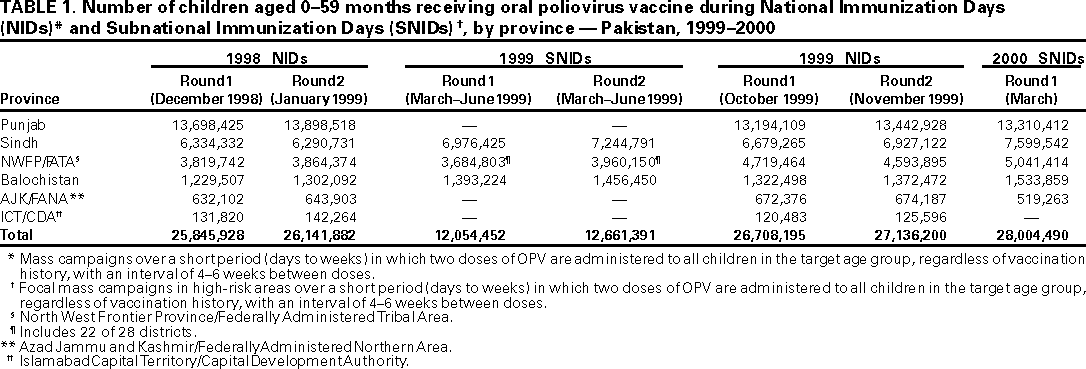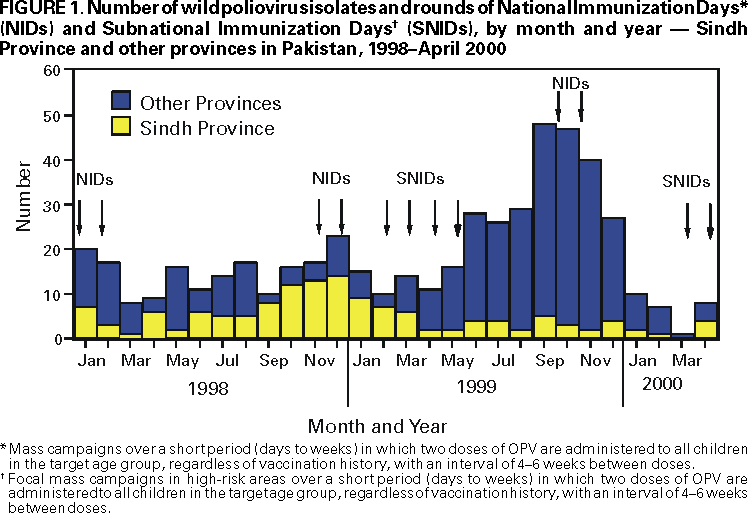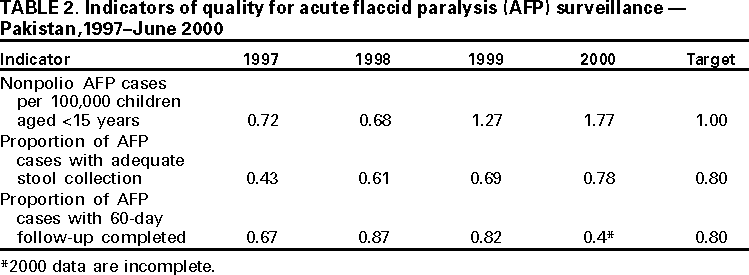 |
|
|
|
|
|
|
| ||||||||||
|
|
|
|
|
|
|
||||
| ||||||||||
|
|
|
|
|
Persons using assistive technology might not be able to fully access information in this file. For assistance, please send e-mail to: mmwrq@cdc.gov. Type 508 Accommodation and the title of the report in the subject line of e-mail. Progress Toward Poliomyelitis Eradication --- Pakistan, 1999--June 2000In 1988, the World Health Assembly resolved to eradicate poliomyelitis globally by the end of 2000 (1). Although polio remains endemic in Pakistan, which reported 60% of all polio cases in the World Health Organization's (WHO) Eastern Mediterranean Region during 1999, substantial progress has been made, particularly in acute flaccid paralysis (AFP) surveillance (2). This report summarizes progress toward polio eradication in Pakistan. Routine Vaccination CoverageDuring 1990--1999, reported coverage estimates of children aged 0--11 months with >3 doses of oral poliovirus vaccine (OPV3) ranged from 57%--83% (3); however, surveys in 1998 and 1999 reported <60% coverage. In 1999, coverage by province ranged from 27% in Balochistan to 62% in Punjab, and during January--March 2000, surveys conducted in 20 Pakistan districts indicated OPV3 coverage of 19%--82% (median: 43%). Supplemental Vaccination ActivitiesEradication activities in Pakistan began in 1994 with National Immunization Days* (NIDs), followed by two rounds of NIDs per year. In the 1999 NIDs, approximately 26 million children aged <5 years were vaccinated (Table 1). Coverage with >1 dose of OPV ranged from 72% to 99% (median: 93%) among the districts. During the second round, vitamin A was administered to 22.5 million children aged 6--59 months. In 1998, Pakistan implemented Subnational Immunization Days (SNIDs) in districts bordering Afghanistan and Iran to coincide with NIDs in those countries. In 1999, a supplemental campaign was conducted coinciding with NIDs in Afghanistan and included 40% of the children aged <5 years in Pakistan. As a result of door-to-door vaccination in both campaigns, 7%--15% more children were vaccinated than during fixed site NIDs. The greatest increase in vaccination occurred in Sindh Province (Table 1), followed by a significant decline in the number of wild poliovirus isolates in Sindh Province (Figure 1). Because of increased coverage and a decline in the number of wild poliovirus isolates, door-to-door vaccination was adopted for all campaigns in 2000. During March--June, Pakistan conducted a two-round supplemental campaign covering the entire country in four phases. Monitoring was more intensive than in previous campaigns, and reports from the first round indicate that coverage has increased in most areas (Table 1). Another nationwide door-to-door campaign is planned for October--November 2000. AFP SurveillanceAFP surveillance began in Pakistan in 1995 but was not fully functional until 1998. In 1999 and early 2000, provincial surveillance officers were hired by WHO to provide continuous training and technical assistance to staff in all provinces. Stop Transmission of Polio (STOP) teams (i.e., groups of international health professionals) have been deployed in 3-month rotations to assist ministry of health staff with polio eradication activities and to improve surveillance quality. A nonpolio AFP rate of >1 per 100,000 children aged <15 years is the measure of a sensitive AFP surveillance system. During 1997 and 1998, the nonpolio AFP rates were 0.72 and 0.68 per 100,000 children aged <15 years, respectively (3). In 1999, Pakistan exceeded the WHO-established target of 1.0 with a rate of 1.27 (Table 2). Among the 1329 AFP cases reported in 1999, 921 (69%) had two adequate stool specimens (i.e., two stool samples collected at least 24 hours apart and within 14 days of paralysis onset), and 1093 (82%) cases were followed-up at 60 days after onset to check for residual paralysis. During January--June 2000, the nonpolio AFP rate was 1.8 with 78% adequate stool specimen collection. Until 2000, the WHO clinical classification scheme for reporting polio cases was used in Pakistan. In 1999, 561 AFP cases were classified as confirmed polio. Of the 561 confirmed cases, 328 had wild poliovirus isolated from stool specimens; 265 were poliovirus type 1 (P1) and 63 were poliovirus type 3 (P3). Effective January 2000, the classification scheme was changed to a system in which cases with wild poliovirus isolated are classified as confirmed, and those without adequate specimens but with signs and symptoms consistent with polio are classified as compatible. Cases with inadequate specimens are classified by a review committee of provincial medical experts. Impact of Eradication ActivitiesThe number of reported cases of polio increased 64% from 1998 to 1999 and the nonpolio AFP rate increased from 0.68 to 1.27. P1 and P3 poliovirus remained widespread throughout Pakistan, and isolates were similar genetically to those previously isolated in Pakistan and Afghanistan (CDC, unpublished data, 1999). Poliovirus type 2 has not been isolated in Pakistan since April 1997. During January--April 2000, 28 cases (18 of P1 and 10 of P3) from four provinces had wild poliovirus isolated compared with 54 during January--April 1999. Reported by: National Institutes of Health, Islamabad, Pakistan. Expanded Programme on Immunization, Eastern Mediterranean Region, World Health Organization, Alexandria, Egypt. Dept of Vaccines and Biologicals, World Health Organization, Geneva, Switzerland. Respiratory and Enteric Viruses Br, Div of Viral and Rickettsial Diseases, National Center for Infectious Diseases; Vaccine-Preventable Disease Eradication Div, National Immunization Program, CDC. Editorial Note:A meeting in Pakistan of the Interagency Coordination Committee§ in February 2000, identified several issues that may contribute to the large number of susceptible children not being reached by routine vaccination coverage and supplemental campaigns in Pakistan. Nomads, the economically disadvantaged, and displaced persons, such as Afghan refugees, are particularly difficult to reach and are often a source of new polio cases. Also, conflict in adjacent Afghanistan affects eradication efforts in Pakistan. Tentative plans for 2001 include three rounds of door-to-door vaccination starting in January followed by another two rounds in the fall. Increased cross-border coordination of vaccination campaigns is planned and should provide improved coverage to mobile populations. The Ministry of Health has set a goal to expand access to vaccination services and to increase routine coverage to 80% by 2002, and AFP surveillance data will be used to target areas inadequately covered by mass campaigns. Thorough follow-up case investigations will be performed and areas with multiple AFP cases, low vaccination coverage, or wild poliovirus isolates will undergo additional vaccination rounds. With this level of activity and intensification, the interruption of wild poliovirus transmission appears feasible in Pakistan in 2001. References
* Mass campaigns over a short period (days to weeks) in which two doses of OPV are administered to all children in the target age group, regardless of vaccination history, with an interval of 4--6 weeks between doses. Focal mass campaigns in high-risk areas over a short period (days to weeks) in which two doses of OPV are administered to all children in the target age group, regardless of vaccination history, with an interval of 4--6 weeks between doses. § Participants included regional directors of United Nations Children's Fund (UNICEF) and WHO, Pakistan government officials, and representatives of several partner agencies (Rotary International, CDC, USAID, the governments of Australia, Canada, Italy, and Japan, the Asian Development Bank, and the World Bank). Table 1  Return to top. Figure 1  Return to top. Table 2  Return to top. Disclaimer All MMWR HTML versions of articles are electronic conversions from ASCII text into HTML. This conversion may have resulted in character translation or format errors in the HTML version. Users should not rely on this HTML document, but are referred to the electronic PDF version and/or the original MMWR paper copy for the official text, figures, and tables. An original paper copy of this issue can be obtained from the Superintendent of Documents, U.S. Government Printing Office (GPO), Washington, DC 20402-9371; telephone: (202) 512-1800. Contact GPO for current prices. **Questions or messages regarding errors in formatting should be addressed to mmwrq@cdc.gov.Page converted: 8/24/2000 |
|||||||||
This page last reviewed 5/2/01
|